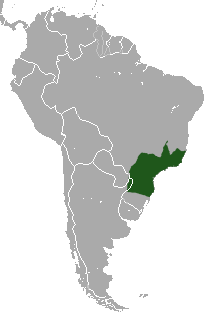Black capuchin
| Black capuchin[1] | |
|---|---|

| |
| Black capuchin in Argentina | |
| Scientific classification | |
| Kingdom: | Animalia |
| Phylum: | Chordata |
| Class: | Mammalia |
| Order: | Primates |
| Suborder: | Haplorhini |
| Infraorder: | Simiiformes |
| Family: | Cebidae |
| Genus: | Sapajus |
| Species: | S. nigritus
|
| Binomial name | |
| Sapajus nigritus (Goldfuss, 1809)
| |

| |
| Combined range of S. n. nigritus and S. n. cucullatus. S. n. robustus is found just northeast of this range (see text). | |
The black capuchin, (Sapajus nigritus), also known as the black-horned capuchin,[2] is a capuchin monkey from the Atlantic Forest in south-eastern Brazil and far north-eastern Argentina. Historically, it was included as a subspecies of the tufted capuchin.[1]
Taxonomy[]
The black capuchin was originally named Cebus nigritus or Cebus apella nigritus, and while this has been changed, a lot of sources still name the black capuchin as part of the genus Cebus.[3]
Biology[]
The black capuchin is a social animal. It likes to live in groups, usually consisting of 6 to 20 members, and is hierarchal. Despite the fact that these groups tend to be made up of more females than males, the alpha female of the group is submissive to the alpha male.
Communication within groups consists of bodily, facial and vocal communications. One example of this is the 'scream embrace mechanism’, a high pitched called used to regroup (usually male) members of a group.[4]
Habitat[]
The black capuchin is found in the Atlantic region of North-eastern Argentina and South-eastern Brazil, with its habitat overlapping with other capuchin species. They are considered arboreal, mainly dwelling in the tree canopy, however will also drop to the forest floor to forage, where insects and nuts are most abundant.[5]
Subspecies[]
The black capuchin has three subspecies: Sapajus n. nigritus (nominate) and S. n. cucullatus are found in the southern part (the former eastwards, and the latter westwards) of this species' range, and both have a distinctive pair of tufts on the crown, as also suggested by the alternative common name of this species; black-horned capuchin. The last subspecies, the crested or robust tufted capuchin (S. n. robustus) is found in the northern part of this species' range (north of the Doce River), and has a median conical crest on the crown.[6] It is sometimes considered a separate species.[7]
Status[]
The black capuchin's population number is unknown, but thought to be declining. This is due mostly to habitat loss, hunting, and the pet trade,[8] however the species has been observed to be able to survive in fragmented and sparse areas of canopy.[5] The two southern subspecies remain relatively widespread and are rated as Near Threatened by the IUCN.[2] The distinctive northern subspecies has a far more restricted distribution and it is considered Endangered.[9]
References[]
- ^ a b Groves, C. P. (2005). Wilson, D. E.; Reeder, D. M. (eds.). Mammal Species of the World: A Taxonomic and Geographic Reference (3rd ed.). Baltimore: Johns Hopkins University Press. pp. 137–138. ISBN 0-801-88221-4. OCLC 62265494.
- ^ a b c Ludwig, G.; de Melo, F.R.; Martins, W.P.; Miranda, J.M.D.; Lynch Alfaro, J.W.; Alonso, A.C.; dos Santos, M.C.; Rímoli, J. (2021). "Sapajus nigritus". IUCN Red List of Threatened Species. 2021: e.T136717A192593806. doi:10.2305/IUCN.UK.2021-1.RLTS.T136717A192593806.en. Retrieved 19 November 2021.
- ^ "Black-horned capuchin - Sapajus nigritus". Encyclopedia of Life. Retrieved 3 March 2017.
- ^ "Black-horned capuchin videos, photos and facts - Cebus nigritus". ARKive. Archived from the original on 30 May 2009. Retrieved 3 March 2017.
- ^ a b "Black capuchin | Planet of the monkeys". planetofthemonkeys.com. Archived from the original on 5 April 2017. Retrieved 4 April 2017.
- ^ Rylands, A. B., Kierulff, M. C. M., & Mittermeier, R. A. (2005). Notes on the taxonomy and distributions of the tufted capuchin monkeys (Cebus, Cebidae) of South America. Lundiana 6 (supp.): 97-110
- ^ Silva Jr., J. de S. (2001). Especiação nos macacos-prego e caiararas, gênero Cebus Erxleben, 1777 (Primates, Cebidae). Ph.D. thesis. Federal University of Rio de Janeiro, Brazil
- ^ Wildlife as Canon sees it. n.a.. National Geographic Magazine, June 2008.
- ^ Kierulff, M.C.M.; Mendes, S.L.; Rylands, A.B. (2015). "Sapajus robustus". IUCN Red List of Threatened Species. 2015: e.T42697A70614762. doi:10.2305/IUCN.UK.2015-1.RLTS.T42697A70614762.en.
| Wikispecies has information related to Black Capuchin. |
| Wikimedia Commons has media related to Black Capuchin. |
- IUCN Red List near threatened species
- Capuchin monkeys
- Mammals of Brazil
- Mammals of Argentina
- Fauna of the Atlantic Forest (biome)
- Mammals described in 1809
- Primates of South America
- New World monkey stubs
